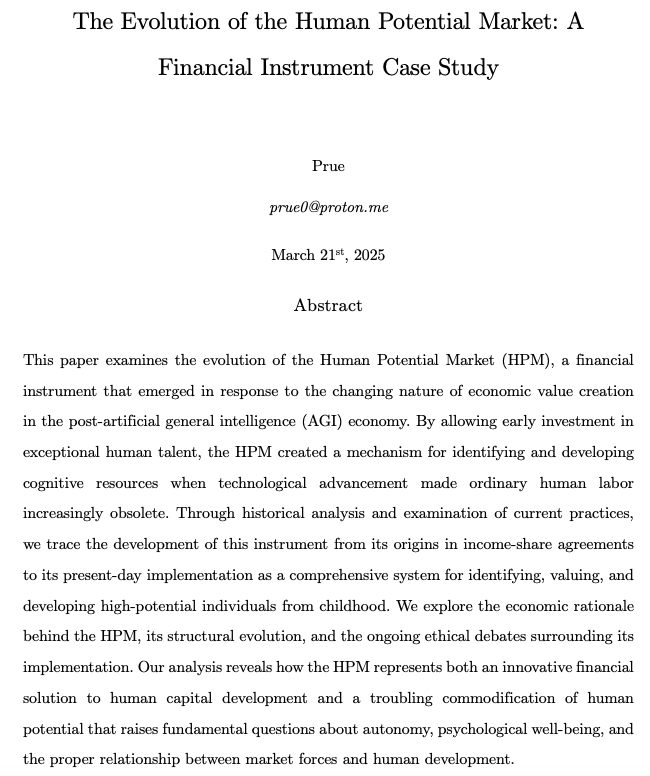
Abstract
This paper examines the evolution of the Human Potential Market (HPM), a financial instrument that emerged in response to the changing nature of economic value creation in the post-artificial general intelligence (AGI) economy. By allowing early investment in exceptional human talent, the HPM created a mechanism for identifying and developing cognitive resources when technological advancement made ordinary human labor increasingly obsolete. Through historical analysis and examination of current practices, we trace the development of this instrument from its origins in income-share agreements to its present-day implementation as a comprehensive system for identifying, valuing, and developing high-potential individuals from childhood. We explore the economic rationale behind the HPM, its structural evolution, and the ongoing ethical debates surrounding its implementation. Our analysis reveals how the HPM represents both an innovative financial solution to human capital development and a troubling commodification of human potential that raises fundamental questions about autonomy, psychological well-being, and the proper relationship between market forces and human development.
1 Introduction
In economies transformed by artificial general intelligence (AGI), where routine cognitive and manual labor has been largely automated, exceptional human creativity and innovation have become exponentially more valuable resources. The Human Potential Market (HPM) emerged as a response to this economic reality, creating financial instruments that allow for early identification and investment in human potential.
This paper traces the evolution of the HPM from its conceptual origins through its present implementation, examining its economic logic, structural development, psychological impact on participants, and the ethical questions it raises about the commodification of human potential.
The HPM represents a significant shift in how society finances talent development and structures value capture. Unlike traditional education financing models that primarily focused on immediate skill acquisition for near-term employment, the HPM takes a long-term approach to human capital development, viewing exceptional individuals as assets whose future output can be partially securitized in the present to fund their development.
2 Historical Development of the Human Potential Market
2.1 Precursors to the Modern HPM
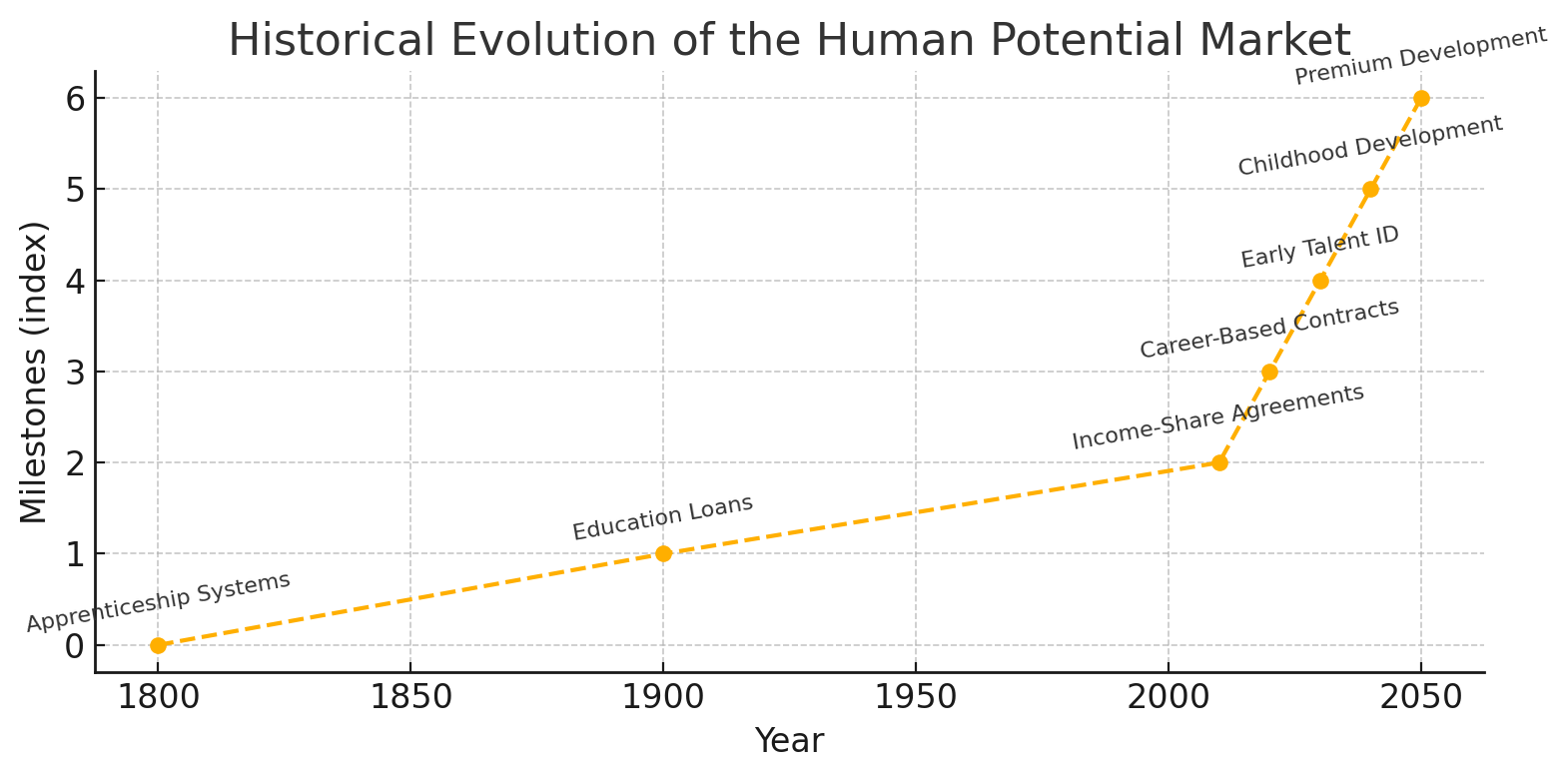
The conceptual foundations of the HPM can be traced to various historical mechanisms for financing human capital development. Early precursors included:
- Apprenticeship Systems (Pre-Industrial Era): Master craftsmen invested time and resources in apprentices in exchange for labor and a percentage of their future earnings.
- Education Loans (19th-20th Centuries): Government and private lending programs began financing higher education based on the premise that improved human capital would yield future returns.
- Income-Share Agreements (Early 21st Century): These agreements, pioneered by educational institutions and private investors, provided education funding in exchange for a percentage of recipients’ future income over a fixed period.
2.2 The Emergence of Modern HPM
The transformation from limited income-share agreements to comprehensive human potential markets occurred through several pivotal developments:
- College-Focused Income Shares (2010s): Initially limited to higher education financing, these early models typically claimed 10-20% of graduates’ income for 5-10 years.
- Career-Based Income Contracts (2020s): As traditional employment models eroded, career development firms began offering more comprehensive services in exchange for longer-term income claims.
- Early Talent Identification Programs (2030s): With advancements in cognitive science and predictive analytics, institutions began identifying exceptional talent earlier, offering development resources in exchange for future income shares.
- Childhood Development Agreements (2040s): The formal establishment of comprehensive childhood investment programs, where firms identified promising children and offered full developmental support in exchange for partial rights to their lifetime intellectual and creative output.
- The Premium Development Track (2050s): The current SOTA includes highly sophisticated identification mechanisms, A-tier development programs, and auction-based pricing of shares in identified high-potential individuals.
2.3 Terminology Evolution
The terminology surrounding the HPM has evolved significantly over time, reflecting changing attitudes toward the practice and attempts to position it favorably in public discourse:
- Income-Share Agreements (2010s): The original term focused on the contractual nature of the arrangement.
- Human Capital Contracts (2020s): Emphasized the investment in skill development rather than simply income redirection.
- Potential Optimization Partnerships (2030s): Shifted focus to mutual benefit and developmental aspects.
- Talent Development Securities (2040s): Introduced financial market terminology to normalize the securitization of human potential.
- High Potential Investments (HPIs) (2045-present): The current industry-preferred terminology, emphasizing the investment nature of the arrangement while avoiding direct reference to the human subjects involved.
- Human Potential Market (HPM) (2045-present): The broader market terminology used by academics and critics.
3 Current Structure of the Human Potential Market
3.1 Market Participants
The contemporary HPM involves several key participants:
- Asset Sourcing Firms: Companies like Prometheus Capital specialize in identifying promising children with exceptional potential using sophisticated neural mapping and other assessment tools.
- Development Institutions: Organizations that provide specialized education, training, and environmental optimization for identified high-potential individuals.
- Investment Vehicles: Funds that allow investors to hold diversified portfolios of HPM contracts.
- Auctions and Exchanges: Formal mechanisms for price discovery and trading of HPM shares.
- Subjects: The individuals whose potential is being traded, typically identified in childhood and developed according to optimization protocols.
3.2 Valuation Mechanisms
The valuation of human potential has become increasingly sophisticated:
- Potential Valuation Index (PVI): Algorithmic assessment of cognitive patterns, creativity markers, and other indicators of exceptional ability.
- Environmental Adjustment Factor: Calculates the expected effect of optimal developmental conditions on potential realization.
- Return on Intervention (ROI) Projections: Models estimating the financial impact of specific developmental interventions.
- AI-Enhanced Productivity Multiplier: Estimates how effectively the subject will be able to leverage personalized or general AI systems to enhance their intellectual output.
3.3 Contract Structures
Modern HPM contracts typically include:
- Initial Payment: Funds provided to the subject’s family or caregivers.
- Development Funding: Ongoing investment in education, training, and environmental optimization.
- Income Share Percentage: Typically ranges from 20-40% of all future intellectual property, patents, creative works, and other measurable outputs.
- Duration: Usually extends throughout the productive lifetime of the subject, with some contracts including buyout provisions.
- Performance Benchmarks: Development milestones that subjects must meet to maintain program benefits.
4 Economic Rationale
4.1 Post-AGI Value Creation Dynamics
The economic logic behind the HPM reflects fundamental shifts in value creation in a post-AGI economy:
- Routine Labor Obsolescence: As AGI systems have automated most routine cognitive and manual tasks, the economic value of ordinary human labor has declined precipitously leaving room for asymmetrically skewed outcomes from talented individuals.
- Premium on Exceptional Creativity: The ability to direct and collaborate with advanced AI systems has made truly exceptional human creativity exponentially more valuable.
- Capital Allocation Efficiency: HPM theoretically allows for more efficient allocation of developmental resources to those with the highest potential.
- Risk Pooling: Investment funds holding diversified portfolios of HPM contracts spread risk across multiple high-potential individuals.
4.2 Market Size and Growth
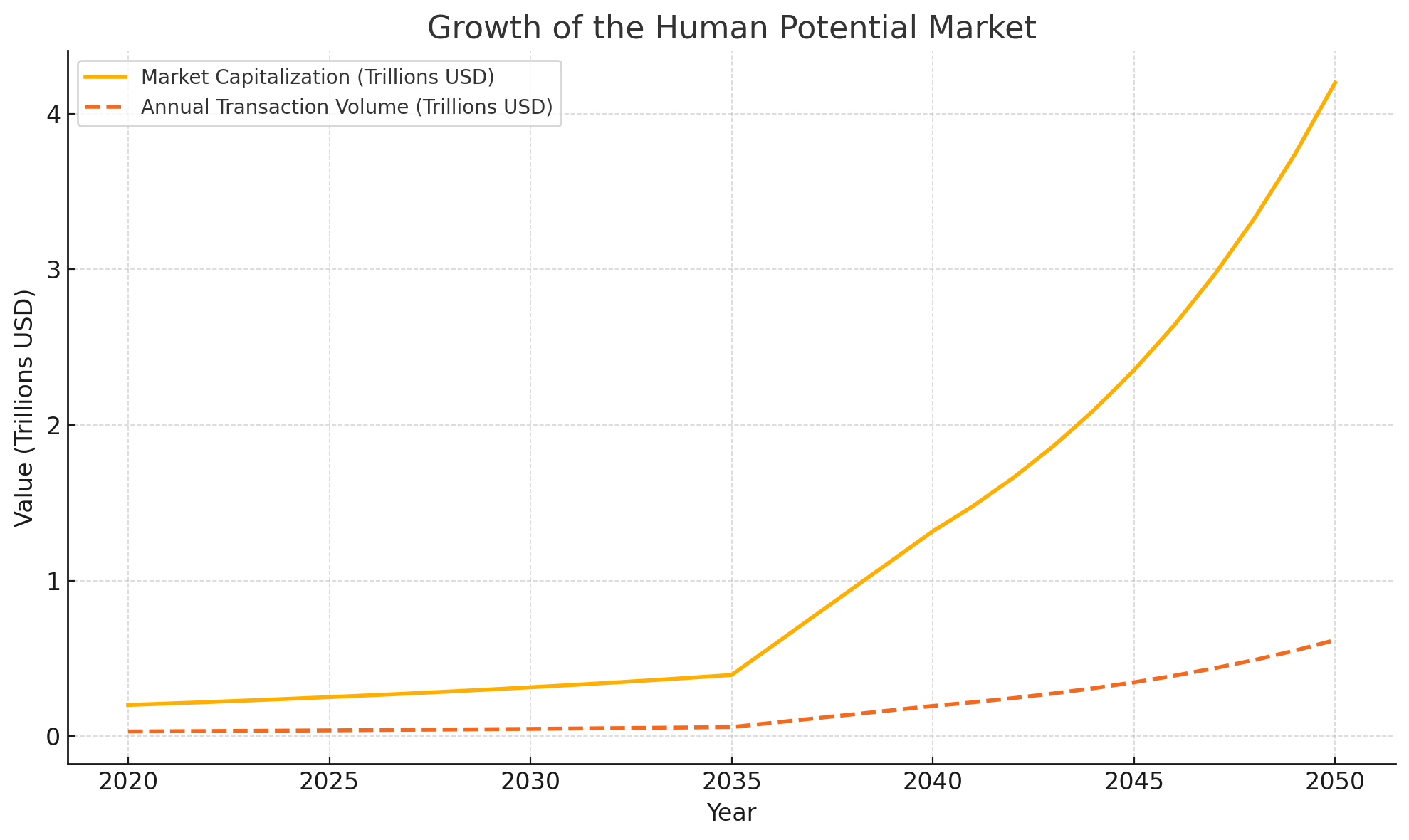
The Human Potential Market has expanded rapidly:
- Current global market capitalization exceeds $4.2 trillion
- Annual transaction volume of approximately $620 billion
- Average annual growth rate of 12.3% over the past decade
- Current participation rate of approximately 0.8% of children born globally
5 Empirical Evidence and Outcomes
5.1 Performance Data

Research on HPM outcomes shows complex results:
- Financial Returns: Average annualized returns of 14.7% over the past decade, outperforming most traditional asset classes.
- Development Effectiveness: Subjects show significant outperformance on standardized metrics compared to control groups with similar baseline potential.
- Subject Life Outcomes: Mixed results, with exceptional professional achievement often accompanied by ranges of psychological distress.
5.2 Psychological Impact on Subjects
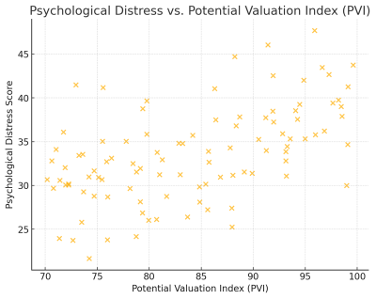
Longitudinal studies on HPM subjects reveal non-statistically large but early concerning patterns that have drawn regulatory and societal scrutiny:
- Higher rates of depression and anxiety: 42% higher than demographically matched control groups.
- Increased substance abuse: 37% higher prevalence than general population.
- Suicidal ideation: Particularly elevated among A-tier assets, peaking in the 30-35 age range.
- Identity formation challenges: Significant difficulties establishing autonomous identity separate from institutional expectations.
- Correlation between potential rating and distress: Higher-rated subjects paradoxically show worse psychological outcomes despite objective success measures.
5.3 Failure Scenarios and Analysis
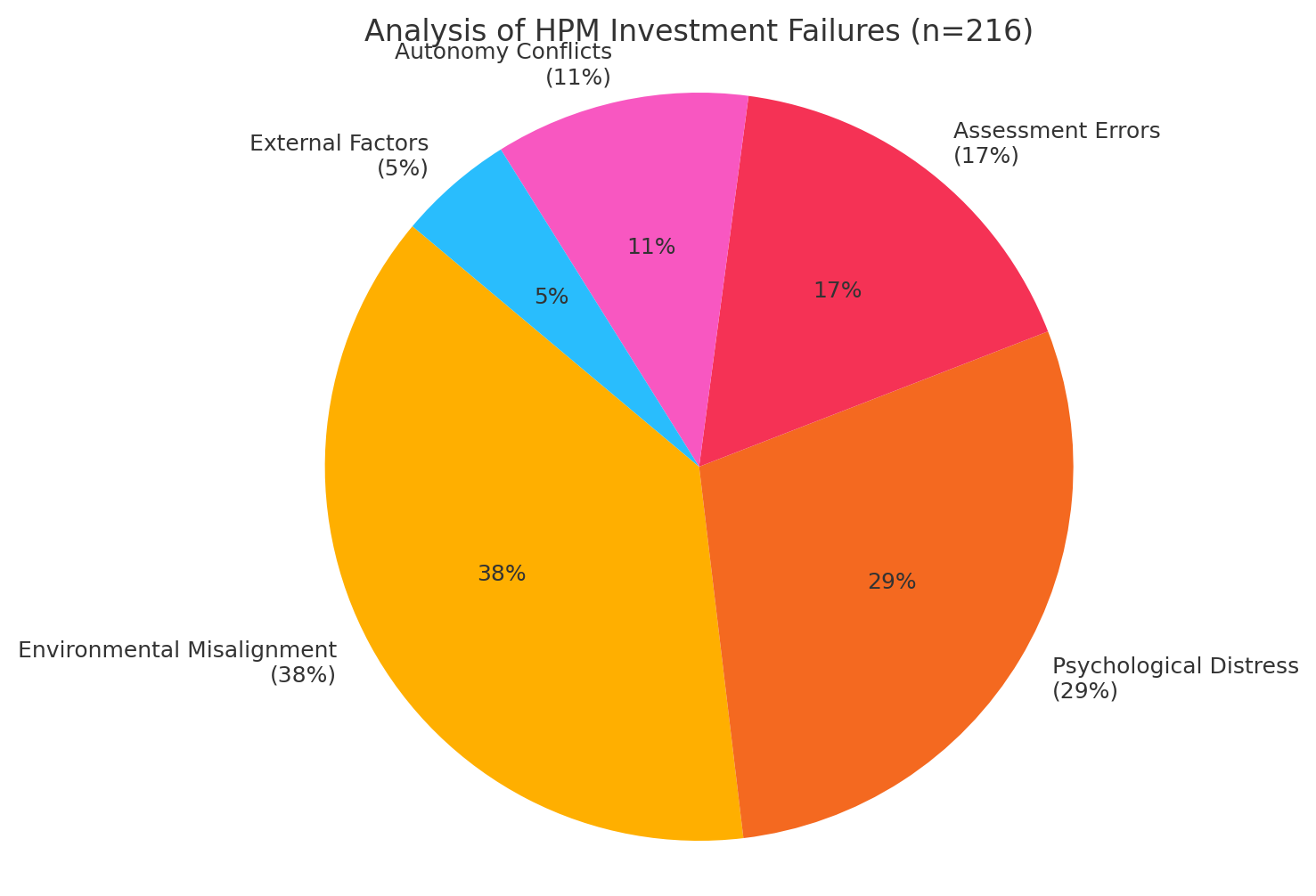
To further understand the limitations and risks inherent in the Human Potential Market, an exploratory analysis of unsuccessful investments was conducted using anecdotal survey data from firms covering 216 distinct human potential assets categorized as investment failures. These cases represent individuals initially assessed as high-potential yet significantly underperformed their predicted benchmarks, resulting in negative returns.
The analysis revealed several prominent hypotheses for investment failures:
- Environmental Misalignment (38% of cases): The most frequently cited reason was suboptimal environmental intervention, including inadequate educational support, mentorship mismatch, or insufficient adaptive flexibility to changing personal or market conditions.
- Psychological Distress and Burnout (29%): High levels of pressure and expectation contributed to psychological issues, diminishing productivity and creativity. Despite significant investment in wellness programs, this distress was exacerbated by overly aggressive performance benchmarking.
- Assessment Errors (17%): Misjudgments in the initial Potential Valuation Index (PVI) assessments led to overestimation of cognitive or creative capacities. Such inaccuracies were often attributed to overreliance on predictive algorithms without sufficient qualitative validation.
- Autonomy Conflicts (11%): Subjects who actively rejected or diverged from prescribed developmental paths due to autonomy-related conflicts exhibited significantly lower outcomes. This group frequently chose personal fulfillment over maximized economic returns, challenging the foundational assumptions of the investment.
- External Unforeseen Factors (5%): Unpredictable life events, including serious health issues, family disruptions, or sudden geopolitical changes, negatively impacted asset productivity, highlighting inherent uncertainties in long-term human capital investments.
These failure scenarios underline the critical importance of robust environmental adaptation, accurate initial assessments, and flexible, autonomy-preserving developmental structures to mitigate downside risks in HPM investments.
6 Ethical and Social Implications
6.1 Autonomy and Self-Determination
HPMs raise fundamental questions about personal autonomy:
- Consent Issues: Contracts are typically signed by parents/guardians when subjects are minors, raising questions about validity of consent. This has been structured with earlier buy-outs and re-opt-ins post-university as of recent due to pressure from external parties.
- Path Determination: Subjects’ educational and career trajectories are heavily influenced by optimization for financial return rather than personal fulfillment.
- Subtle Intervention: Documentation reveals potential systematic manipulation of subjects’ life choices through “gentle guidance” and environmental engineering.
6.2 Social Stratification
The HPM has significant implications for social equality:
- Talent Extraction: Critics argue the system primarily extracts talent from lower socioeconomic backgrounds to serve interests of wealthy investors. We have not observed this at scale though typically this is viewed as a double-edged sword for class mobility.
- Opportunity Distribution: Access to premium development resources is increasingly concentrated among those identified for the HPM.
- Class Reinforcement: The system potentially calcifies social stratification by creating a distinct class of “assets” whose life outcomes are determined early. There are of course barbell outcomes where on the individual asset returns are strongly negative. Investors have pushed to baskets to curb risk but the class mobility point mentioned above remains a strong narrative.
6.3 Regulatory Responses
Various jurisdictions have implemented different regulatory approaches:
- European Union: Strict limitations on contract duration and share percentage, with mandatory autonomy provisions.
- United States: Limited oversight focused primarily on disclosure requirements and minimum age provisions.
- East Asian Markets: Generally permissive regulatory environment with emphasis on creating competitive advantage in human capital development.
- Emerging Market Regions: Varied approaches, with some regions actively encouraging HPM as development strategy and others imposing prohibitions.
7 Current Debates and Reform Initiatives
7.1 Reform Proposals
Several significant reform initiatives are currently being debated:
- Oversight Committees: Independent review bodies to monitor HPM practices and ensure subject well-being.
- Modified Contract Structures: Reduced income share percentages and duration limitations.
- Psychological Support Mandates: Requirements for comprehensive mental health services throughout contract periods.
- Subject Autonomy Provisions: Greater decision-making authority for subjects regarding their development and career paths.
- Reaffirmation Requirements: Mandatory contract reviews when subjects reach majority age, with opportunities to modify terms.
7.2 Industry Response
The HPM industry has responded to criticisms with various initiatives:
- Ethical Practice Standards: Industry associations have developed voluntary standards addressing the most criticized practices.
- Modified Development Models: Some firms have introduced “gentle guidance” approaches that allow more subject autonomy.
- Wellness Programs: Implementation of psychological support services aimed at addressing documented mental health challenges.
- Transparency Initiatives: Greater disclosure of long-term outcome data and contract implications.
8 Theoretical Perspectives
8.1 Economic Efficiency Arguments
Proponents argue the HPM solves several market failures:
- Capital Constraint Alleviation: Provides development resources to those who would otherwise lack access.
- Information Asymmetry Reduction: Professional identification and assessment may identify potential that would otherwise go unrecognized.
- Externality Internalization: Creates direct financial incentives for optimal human capital development.
8.2 Critical Perspectives
Critics offer several theoretical critiques:
- Commodification Theory: The HPM represents an inappropriate extension of market logic to fundamental aspects of human personhood.
- Exploitation Framework: Unequal power dynamics between investors and subjects (especially children and less economically-advantaged families) create inherently exploitative relationships.
- Capabilities Approach: The system potentially undermines capabilities necessary for human flourishing by prioritizing narrow productivity.
9 Future Directions
9.1 Emerging Trends
Several trends suggest possible future directions for the HPM:
- Earlier Identification: Advancing neuroscience enables increasingly early identification of exceptional potential, potentially pushing initial assessments into infancy.
- Genetic Considerations: Growing interest in incorporating genetic markers into potential assessment, raising significant ethical questions.
- Modified Ownership Structures: Experiments with alternative models where subjects retain greater control and larger ownership stakes in their own potential.
- Decentralized Management: Blockchain-based systems for more transparent contract management and execution.
9.2 Research Priorities
Critical research needs include:
- Long-term Psychological Impact: More comprehensive longitudinal studies of psychological outcomes for HPM subjects.
- Alternative Development Models: Comparative research on different approaches to exceptional talent development.
- Ethical Frameworks: Development of robust ethical guidelines grounded in human dignity and autonomy.
- Regulatory Effectiveness: Evaluation of different regulatory approaches and their impacts on subject welfare.
10 Conclusion
The Human Potential Market represents both a sophisticated financial innovation and a profound ethical challenge. While it has created mechanisms for identifying and developing exceptional human talent in an economy transformed by artificial intelligence, it has done so at significant cost to the autonomy and well-being of many participants.
The evolution of the HPM from limited income-share agreements to comprehensive childhood investment programs reflects broader societal shifts in how we conceptualize human potential, education, and the relationship between individual development and market forces. As this market continues to evolve, the fundamental tension between economic efficiency and human dignity remains unresolved.
Future developments in this domain will require careful balancing of innovation and ethical considerations, with particular attention to subject autonomy, psychological well-being, and equitable access to opportunity. The HPM’s evolution will likely be shaped not only by market forces and technological advancements but also by evolving ethical frameworks and regulatory approaches that seek to preserve what is truly valuable in human potential beyond its market price.